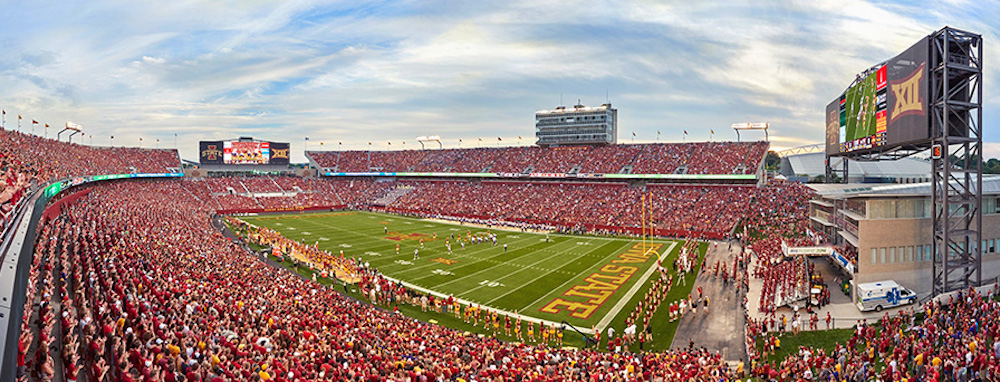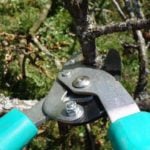
Iowa State University’s football team may not be nationally ranked this season, but the home field where the players compete has been nationally ranked for years.
In 1996 and 2012, the Sports Turf Managers Association named Iowa State’s Jack Trice Stadium as College Football Field of the Year. The university says Jack Trice Stadium “boasts one of college football’s most plush and beautiful fields.”
Here at LawnStarter, we couldn’t agree more. We’d actually go a few yards farther, though: Jack Trice Stadium ranks No. 1 on our list of the Best College Football Fields With Good Ol’ Grass. The Jack Trice field scores a touchdown, from the beautifully painted end zones to the eye-catching midfield logo to the immaculately manicured Kentucky bluegrass.
Tim VanLoo, manager of athletic turf and grounds at Iowa State University
Photo: Blake Lanser/Iowa State Daily
“We try to make it the most consistent playing surface we can so our athletes will know what they get each time on the field. Most of that work comes from late April to late July,” Tim VanLoo, manager of athletic turf and grounds at Iowa State, said in 2012.
To come up with our ranking, we looked at the Sports Turf Managers Association’s list of College Football Field of the Year winners from 1996 through 2014. We then narrowed the list by focusing only on primary football fields, not practice fields, and only on NCAA Division I FBS fields that still have natural grass. Among the nine most aesthetically pleasing fields we settled on, Iowa State surfaced to the top, edging out Northwestern University. Those two schools are the only two-time College Football Field of the Year victors.
Labor of (Lawn) Love
VanLoo told SportsTurf Magazine in 2013 that in recent years, Iowa State’s field had endured a record-breaking flood and a record-breaking drought.
“I am a creature of habit, so I don’t like to stray very far from what has worked before, but Mother Nature usually forces me to change something,” said VanLoo, who’s secretary-treasurer of the Sports Turf Managers Association.
In 2014, VanLoo told the Iowa State Daily newspaper that painting the Jack Trice field for a home game is the most labor-intensive part of maintaining the grass. He says it takes about 55 hours of manpower to paint the field with about 160 to 175 gallons of paint.
Iowa State University’s Jack Trice Stadium
Photo: Iowa State University
Despite the hours of labor and gallons of paint, VanLoo says it would be a “terrible tragedy” to convert the Jack Trice field from natural grass to artificial turf. For one thing, he says, it would be too costly to make the switch.
“With this being an agricultural school and having one of the top turf-grass programs in the country, there’s other things that play into that. I actually think artificial turf will go back the other way and more stadiums will go back to natural turf,” VanLoo told Iowa State Daily.
Turf Truth
Although firm data isn’t available, Casey Carrick, associate sports turf manager at the University of North Carolina, says more college football fields now have artificial turf than natural grass. One reason that college football programs have shifted to artificial turf, he says, is that they perceive it’s easier and cheaper to maintain. But Carrick says that’s not entirely true.
“While they can be a little less maintenance day-to-day, they still require a good amount of preparation and upkeep,” says Carrick, a member of the Sports Turf Managers Association. “I think what a lot of people fail to realize is that once the artificial turf is worn out — in five to eight years — the cost to replace could reach up to $750,000.”
Jack Trice Stadium at dusk
Photo: John Andrus/Iowa State Daily
Carrick, who prefers natural grass over artificial turf, says he doesn’t expect grass football fields to disappear anytime soon, as new innovations are making it easier to grow and maintain the real thing.
“You can’t beat the look and smell of a fresh-cut field,” he says, “and you just don’t get that with an artificial field.”
Latitude With Logos
Carrick cites flexibility as one of the key advantages of natural-grass turf.
“Usually with an artificial field, logos and colors are permanent, so once it’s finished, that’s what you have,” he says. “With a natural-grass surface, the field can have a different mowing pattern each week. Paint, colors and logos can also be changed week to week for a different look.”
Here, we present nine natural-grass fields in college football that definitely deserve a look.
1. Jack Trice Stadium
Iowa State University
Ames, IA
Photo: Iowa State University
2. Ryan Field
Northwestern University
Evanston, IL
Photo: Northwestern University
3. Folsom Field
University of Colorado
Boulder, CO
Photo: University of Colorado
4. Ben Hill Griffin Stadium
University of Florida
Gainesville, FL
Photo: Reddit
Order lawn care in minutes on our Orlando lawn care and Jacksonville lawn care pages so you can spend more time watching the Gators win from home.
5. Spartan Stadium
Michigan State University
East Lansing, MI
Photo: Michigan State University
6. Davis Wade Stadium
Mississippi State University
Starkville, MS
Photo: Mississippi State University
7. Scott Stadium
University of Virginia
Charlottesville, VA
Photo: University of Virginia
8. Lane Stadium
Virginia Tech
Blacksburg, VA
Photo: Virginia Tech
Live around Virginia? We offer top-notch lawn care services in Arlington, Richmond, and Virginia Beach!
9. Kyle Field
Texas A&M University
College Station, TX
Photo: Airfield Systems
We know Aggie fans come from far and wide to catch all the action at Kyle Field. Whether you live in Houston, San Antonio, Austin, or Dallas/Fort Worth, let us take care of the weekend yard work so you can enjoy more Saturdays relaxing in College Station.

















